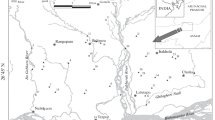Abstract
Trace element analysis for five elements namely, Ba, Sr, Mn, Cr and Cd was carried out on both ash weight and dry weight basis for mine water and coconut water from Mangampeta barite area. The concentration of trace elements is strikingly different in the coconut water when compared with that of mine water. The coconut plant has the ability to control the presence of certain inorganic elements in its water, whatever be the amount of those elements present in irrigation water. Further, biogeochemical studies of coconut water may be of considerable importance in balneology.
Similar content being viewed by others
References
Bowie, S.H.U. and Webb, J.S. (eds.), 1980. Environmental Geochemistry and Health. The Royal Society, London.
CSIR (Council of Scientific and Industrial Research) 1950. The Wealth of India, A dictionary of Indian Raw Materials and Industrial Products. New Delhi.
Fazeli, M.S., Satyanarayanan, S., Satish, P.N. and Lata Muthanna 1991. Effects of paper mill effluents on accumulation of heavy metals in coconut trees near Nanjangud, Mysore District, Karnataka, India Environmental Geology and Water Science, 17 (1), 47–50.
Karunakaran, C. 1976. Sulphur isotopic compositon of barite and pyrites from Mangampeta, Cuddaph District, Andhra Pradesh. Journal of the Geological Society of India, 17 (2), 182–185.
Kurien, T.K., Setti, D.N., Neelakantam, S., Suthanandam, P and Roy, S. 1977. Baryte mineralisation and its origin, Mangampeta, Cuddapah District, Andhra Pradesh, The Indian Mineralogist, 18, 1–6.
Prasad, E.A.V. and Niranjan Prasad, D. 1991. Coconut tree in biogeochemical exploration, (abstract), 10th International Symposium on Environmental Biogeochemistry. US Geological Survey, USA.
Rose, A.W., Hawkes, H.E. and Webb, J.S. 1979. Geochemistry in Mineral Exploration. Academic Press, London.
Sarma, P.P. 1979. Astanga Sangrahamu (in Sanskrit and Telugu). Telugu Akademi, Hyderabad.
Thampan, P.K. 1981. Handbook on Coconut Palm. Oxford and IBH Publishing Company, New Delhi.
Thornton, I. (ed.) 1983. Applied Environmental Geochemistry. Academic Press, New York.
Underwood, E.J. 1971. Trace Elements in Human and Animal Nutrition, 3rd edn. Academic Press, New York.
Valiathan, M.S., Eapen, J.T. and Mathews, C.K. 1992. Reciprocal relationship between magnesium and cerium as a common basis for coconut root (wilt) and a human cardiomyopathy. Current Science, 63, 565–567.
Viswanath, K and Sastry, A.V.R. 1983. Volcanogenic rocks from Mangampeta area, Andhra Pradesh. Indian Journal of Earth Sciences, 10 (2), 142–151.
Author information
Authors and Affiliations
Rights and permissions
About this article
Cite this article
Prasad, E.A.V., Raghul, V. Trace elements in coconut water—a preliminary study. Environ Geochem Health 16, 76–78 (1994). https://doi.org/10.1007/BF00209828
Received:
Accepted:
Issue Date:
DOI: https://doi.org/10.1007/BF00209828




